Varanasi Ropeway (Cable Car): Route, Timings, Tickets & Latest Updates
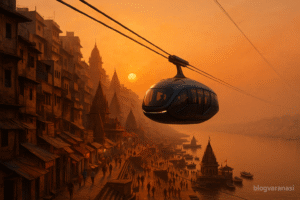
Wow, it’s a game changer for the Varanasi people and the tourists to move from one place to another without getting stuck in traffic.
Imagine flying above the ancient lanes of Kashi, watching the Ganga flow peacefully below, and reaching the Kashi Vishwanath Temple without getting stuck in traffic. It feels like a dream, and soon it becomes real.
Varanasi, one of the world’s oldest cities, is now embracing modern transport with India’s first urban cable car system “Varanasi Ropeway”. This upcoming ropeway will not only ease traffic but also offer a unique aerial view of the spiritual capital.
Let’s explore everything about the Varanasi Cable Car Project.
What Is the Varanasi Cable Car?
The Varanasi Cable Car, also called the Ropeway, is India’s first urban public transport cable car system, and as a Varanasi resident, I am very proud that it started in our city. It helps locals and tourists to avoid traffic and enjoy a drone view of the holy city.
Route and Stations
The first phase of the cable car covers around 3.75 km with 5 main stations:
- Varanasi Cantonment (Start Point)
- Rath Yatra
- Girja Ghar
- Godowlia Chowk
- Kashi Vishwanath Corridor (End Point)
This route connects Varanasi Junction (Cantt Railway Station) to the Kashi Vishwanath Temple area, one of the busiest and most important pilgrimage spots.
Timings
- Expected Operating Hours: 6:00 AM to 10:00 PM (daily)
(May change after full launch)
Varanasi Ropeway Ticket Price (Expected)
- General Ticket: ₹100–₹150 one way
- Tourist Ticket/Return/Day Passes: May be available in the future
For students, senior citizens, and locals, the government may introduce some discounted rates or passes.
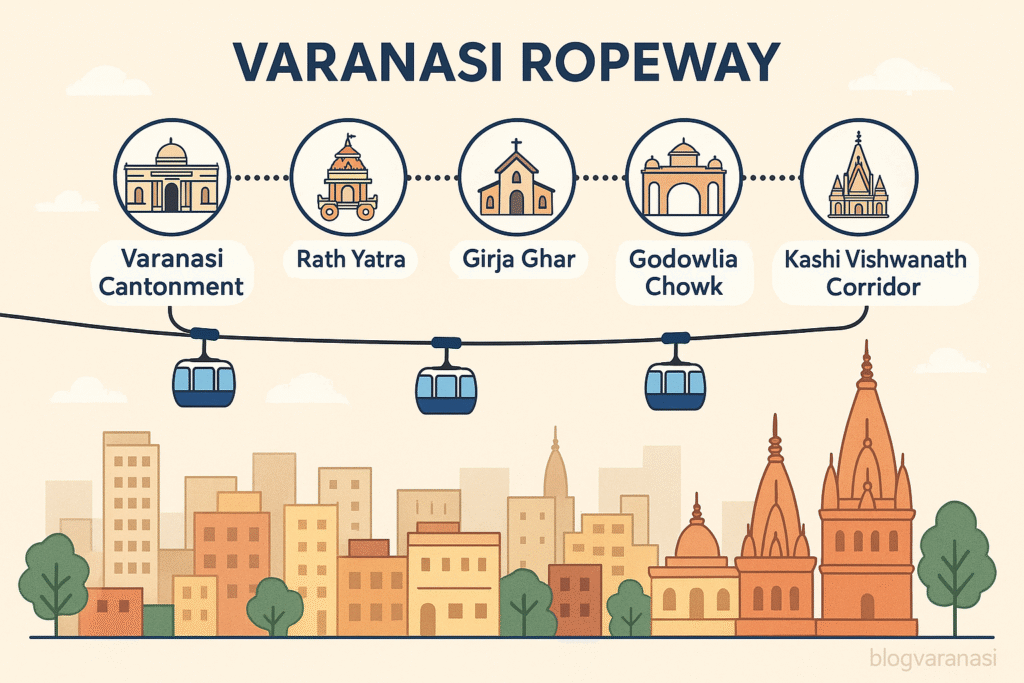
Technology and Features
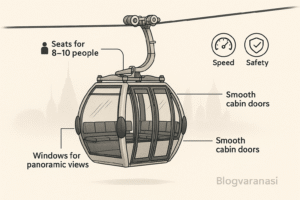
- Built by: National Highways Logistics Management Limited (NHLML)
- Technology: Mono-cable detachable gondola system
- Speed: ~21 km/h
- Cabins: Each cable car (gondola) can carry 8-10 passengers
- Frequency: One gondola every 90 seconds
- Capacity: 5,000 people per hour in both directions
What You’ll See from the Ropeway
- Aerial view of temples, markets, and the narrow lanes of Kashi
- Bird’s-eye view of the Ganga ghats
- A glimpse of old and new Varanasi from above

Benefits of the Ropeway
- Avoid traffic jams in crowded areas like Godowlia
- Quick access to major religious and tourist spots
- Eco-friendly travel with reduced noise and air pollution
- Great for tourists, pilgrims, and local commuters
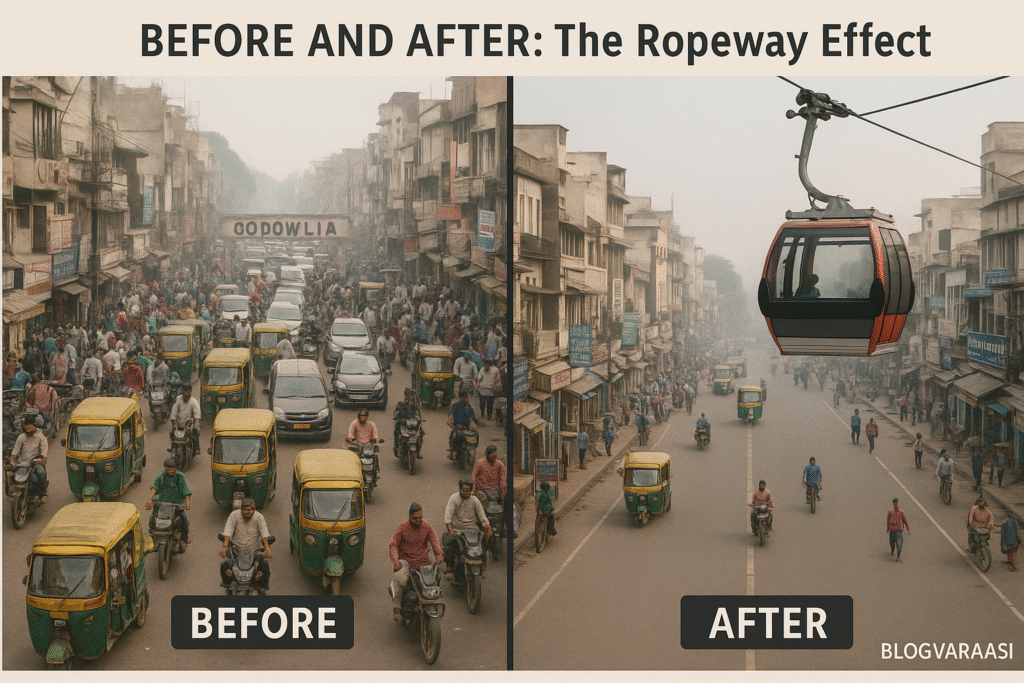
When Will It Start?
- The trial runs have already begun (as of 2024)
- Public opening expected in late 2025 or early 2026
Why This Project Matters
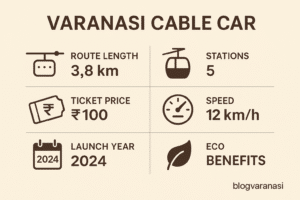
In Varanasi, millions of pilgrims and tourists visit every year. The narrow lanes often face massive congestion. This cable car will:
- Cut travel time drastically
- Reduce traffic pressure in core areas like Godowlia
- Promote eco-friendly transportation
- Boost the city’s smart city vision
Quick Summary Table
| Feature | Detail |
| Total Length | 3.75 km |
| Stations | 5 |
| Travel Time | 16–20 minutes |
| Ticket Price | ₹100–₹150 (expected) |
| First Urban Cable Car in India | ✅ |
| Expected Launch | Late 2025/Early 2026 |
Final Thoughts
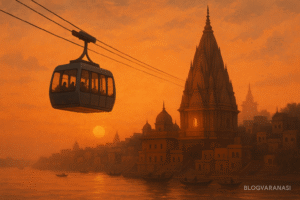
The Varanasi Cable Car is a game changer for Varanasi traffic; it’s not just a transport project – it’s a vision. A vision where spiritual heritage connects with smart mobility. It will not only change the way we travel in Kashi but also the way we see it.
So the next time when you plan a Varanasi trip, be ready to skip the road and take to the skies!
FAQs
How can I book Varanasi ropeway tickets online?
As of now, online booking is not live. Once operational, tickets are expected to be available through official portals, government apps, and third-party travel platforms. Stay tuned for announcements on booking apps and websites.
What is the best time to ride the Varanasi cable car for views?
Early morning (sunrise) and evening (sunset) rides offer the best aerial views of the Ganga, ghats, and temples. These timings also avoid harsh sunlight and rush hours.
Is the Varanasi Ropeway project part of Smart City development?
Yes. The ropeway is a key component of Varanasi’s Smart City initiative, focusing on sustainable, modern infrastructure that supports tourism and daily commuting.
Will the ropeway reduce traffic near Kashi Vishwanath Temple?
Definitely. The ropeway connects directly to the Kashi Vishwanath Corridor, bypassing the congested Godowlia area, reducing local traffic and travel time significantly.
How long does the Varanasi ropeway ride take from start to end?
The full journey from Varanasi Cantonment to Kashi Vishwanath is expected to take 16 to 20 minutes, offering a smooth and scenic ride.
Will local vendors or markets be affected by the ropeway?
The project aims to reduce street congestion without disrupting local businesses. In fact, better access may boost footfall in nearby markets and benefit vendors.
Is there a mobile app for Varanasi cable car updates?
A dedicated app is likely to be launched with real-time updates, ticketing, and travel information once the service goes public.
Are there any combo passes for ropeway and other Varanasi attractions?
Such tourist-friendly passes are under consideration and may be launched post-inauguration in partnership with tourism departments or tour operators.
Can I get off at intermediate stations like Rath Yatra or Godowlia?
Yes. The cable car system has five designated stations, and passengers can board or exit at any of these stops based on their destination.
Will the Varanasi ropeway run during religious festivals like Dev Deepawali or Mahashivratri?
Yes. In fact, it is expected to be a major travel option during festivals, though schedules may be extended or adjusted to manage higher crowds.
Author: Alok Mishra
Alok Mishra is a seasoned SEO professional and a proud native of Varanasi. Born and brought up in the spiritual capital of India, he combines deep-rooted cultural knowledge with expert digital insight. Through his writing, Alok offers authentic, insider perspectives that bring the timeless essence of Varanasi to life for every reader.
